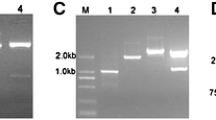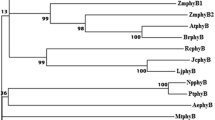Abstract
Chinese cabbage plants remain in the vegetative growth phase until they have experienced prolonged exposure to cold temperature, known as vernalization. This inhibition of flowering is caused by the high levels of FLOWERING LOCUS C (FLC) expression. To increase the product value of Chinese cabbage by inhibiting the floral transition, three genes (BrFLC1, BrFLC2, and BrFLC3) homologous to the AtFLC gene, which encodes a floral repressor, were isolated from the Chinese cabbage ‘Chiifu’. These genes showed high similarity to AtFLC, although the putative BrFLC1 protein contained ten more residues than AtFLC. The BrFLC genes were expressed ubiquitously, except that BrFLC3 was not expressed in roots. BrFLC1 and BrFLC2 showed stronger expression than BrFLC3 in unvernalized and vernalized Chinese cabbage. The expression levels of the three BrFLC genes were lower in an early-flowering Chinese cabbage, suggesting that the BrFLC transcript level was associated with flowering time. Constitutive expression of the BrFLC genes in Arabidopsis significantly delayed flowering, which was also observed in transgenic Chinese cabbage overexpressing BrFLC3. These results suggest that the BrFLC genes act similarly to AtFLC. Our results provide a technique for controlling flowering time in Chinese cabbage and other crops to produce high yields of vegetative tissues.












Similar content being viewed by others
Abbreviations
- At:
-
Arabidopsis thaliana
- BA:
-
6-Benzylaminopurine
- Bn:
-
Brassica napus
- Br:
-
Brassica rapa L. ssp. pekinensis
- FLC:
-
FLOWERING LOCUS C
- NAA:
-
α-Naphthaleneacetic acid
References
Boss PK, Bastow RM, Mylne JS, Dean C (2004) Multiple pathways in the decision to flower: enabling, promoting, and resetting. Plant Cell 16:S18–S31
Church GM, Gilbert W (1984) Genomic sequencing. PNAS 81:1991–1995
Gordon G, Simpson AR, Gendall, Caroline D (1999) When to Switch to flowering. Annu Rev Cell Dev Biol 99:519–550
He Y, Amasino RM (2005) Role of chromatin modification in flowering-time control. Trends Plant Sci 10:30–35
Hepworth SR, Valverde F, Ravenscroft D, Mouradov A, Coupland G (2002) Antagonistic regulation of flowering-time gene SOC1 by CONSTANS and FLC via separate promoter motifs. EMBO J 21:4327–4337
Jack T (2004) Molecular and genetic mechanisms of floral control. Plant Cell 16:S1–S17
Johanson U, West J, Lister C, Michaels S, Amasino R, Dean C (2000) Molecular analysis of FRIGIDA, a major determinant of natural variation in Arabidopsis flowering time. Science 290:344–347
Lee I, Amasino RM (1995) Effect of vernalization, photoperiod, and light quality on the flowering phenotype of Arabidopsis plants containing the FRIGIDA gene. Plant Physiol 108:157–162
Lee YH, Lee SB, Suh SC, Byun MO, Kim HI (2000a) Herbicide-resistant cabbage (Brassica oleracea ssp. capitata) plants by Agrobacterium-mediated transformation. J Plant Biotechnol 2:35–41
Lee H, Suh SS, Park E, Cho E, Ahn JH, Kim SG, Lee JS, Kwon YM, Lee I (2000b) The AGAMOUS-LIKE 20 MADS domain protein integrates floral inductive pathways in Arabidopsis. Genes Dev 14:2366–2376
Li Z, Zhao L, Cui C, Kai G, Zhang L, Sun X, Tang K (2005) Molecular cloning and characterization of anti-bolting related gene (BrpFLC) from Brassica rapa ssp. Pekinensis. Plant Sci 168:407–413
Lin SI, Wang JG, Poon SY, Su CI, Wang SS, Chiou TJ (2005) Differential regulation of FLOWERING LOCUS C expression by vernalization in cabbage and Arabidopdsis. Plant Physiol 137:1037–1048
Michaels SD, Amasino RM (1999) FLOWERING LOCUS C encodes a novel MADS domain protein that acts as a repressor of flowering. Plant Cell 11:949–956
Mouradov A, Cremer F, Coupland G (2002) Control of flowering time: interacting pathways as a basis for diversity. Plant Cell S111–S130
Osborn TC, Kole C, Parkin IAP, Sharpe AG, Kuiper M, Lydiate DJ, Trick M (1997) Comparison of flowering time genes in Brassica rapa, B. napus and Arabidopsis thaliana. Genetics 146:1123–1129
Ratcliffe OJ, Nadzan GC, Reuber TL, Riechmann JL (2001) Regulation of flowering in Arabidopsis by an FLC homologue. Plant Physiol 126:122–132
Schranz ME, Quijada P, Sung SB, Lukens L, Amasino R, Osborn TC (2002) Characterization and effects of the replicated flowering time gene FLC in Brassica rapa. Genetics 162:1457–1468
Sheldon CC, Burn JE, Perez PP, Metzger J, Edwards JA, Peacock WJ, Dennis ES (1999) The FLF MADS box gene: a repressor of flowering in Arabidopsis regulated by vernalization and methylation. Plant Cell 11:445–458
Sheldon CC, Rouse DT, Finnegan EJ, Peacock WJ, Dennis ES (2000) The molecular basis of vernalization: the control role of FLOWERING LOCUS C (FLC). PNAS 97:3753–3758
Shore P, Sharrocks AD (1995) The MADS-box family of transcription factors. Eur J Biochem 229(1):1–13
Shure M, Wesslers S, Federoff N (1983) Molecular identification of the waxy locus in maize. Cell 35:225–233
Simpson GG, Gendall AR, Dean C (1999) When to switch to flowering. Annu Rev Cell Dev Biol 99:519–550
Sung S, Amasino RM (2005) Remembering winter: toward a molecular understanding of vernalization. Annu Rev Plant Biol 56:491–508
Tadege M, Sheldon CC, Helliwell CA, Stoutjesdijk P, Dennis ES, Peacock WJ (2001) Control of flowering time by FLC orthologues in Brassica napus. Plant J 28(5):545–553
Verwoerd TC, Dekker BMM, Hoekema A (1989) A small-scale procedure for the rapid isolation of plant RNAs. Nucleic Acid Res 17:2362
Acknowledgments
This work was supported by Technology Development Program for Agriculture and Forestry, Ministry of Agriculture and Forestry, Republic of Korea and a grant (20050401034783) from BioGreen 21 Program, Rural Development Administration, Republic of Korea. We thank Dongbu Hannong Chem. Co. for providing Chinese cabbage inbred lines with different flowering times. We also thank Min Jung Lee for working on Arabidopsis transformation.
Author information
Authors and Affiliations
Corresponding author
Additional information
Communicated by I. S. Chung
Soo-Yun Kim and Beom-Seok Park have equally contributed to this work.
Rights and permissions
About this article
Cite this article
Kim, SY., Park, BS., Kwon, SJ. et al. Delayed flowering time in Arabidopsis and Brassica rapa by the overexpression of FLOWERING LOCUS C (FLC) homologs isolated from Chinese cabbage (Brassica rapa L. ssp. pekinensis). Plant Cell Rep 26, 327–336 (2007). https://doi.org/10.1007/s00299-006-0243-1
Received:
Revised:
Accepted:
Published:
Issue Date:
DOI: https://doi.org/10.1007/s00299-006-0243-1




